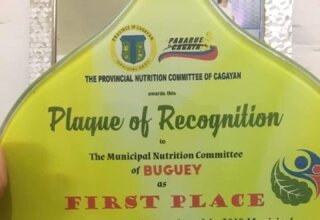
The celebration of Christmas among selected towns in Cagayan is incomplete without a serving of the Sinabalu and Tinubong, two of the most treasured rice desserts in the province.
The common denominator is that both use young bamboos. Basically, there are three types of cooking rice desserts in the Philippines; bibingka, baked with heat coming from above and below baking pan, suman is boiled and puto is steamed.
But Cagayan’s possible bet to world cuisine took itself further to a supposedly fourth type of cooking: sinabalu and tinubong has to be rotated on slow fire to be cooked. Considered as one of Northern Philippines’ culinary icons, these rice desserts proved themselves strong and resistant to fraternization of regional influences. As a matter of fact, they have retained their original ingredients using an original method of cooking
Rizal town is famous for its Sinabalu Festival where the centerpiece is the sinabalu itself. Over in northeastern Cagayan, Tinubong rules the season in the same way as Binalay does to Enrile town.

The common denominator between the two is the use of young bamboos, the vulu (Ilocano bulo), and the utilization of the wild arrow root (Ilocano Sago)leaves inside the medium to protect the deko (Ibanag glutinous rice) from sticking on the bamboo. The leaves add aroma to the deko.
The ingredients for both preparations include glutinous rice, sugar, some salt (especially for sinabalu) and the indispensable kakang gata ( first coconut milk). There are differences, however, in the way the glutinous rice is prepared. For Sinabalu, the whole rice is used while Tinubong prefers ground rice. The former is bereft of any other mixture while the latter is mixed with ground peanuts or cacao which makes it tastier and competitive.
Sinabalu is cooked with longer bamboo containers while the Tinubong prefers the short ones. However, at times, the sizes depend on the whims and caprices of who prepares them. While the top part of the Sinabalu has no virtual cover, that of the Tinubong uses fashioned coconut husks. In Gonzaga, the tinubong is covered with dried banana fibers.
In terms of shelves life, tinubong has an advantage over that of the sinabalu. Maybe it’s because of the amount of sugar used or because of how the glutinous rice is prepare before cooking. The tinubong is best taken with brewed coffee, peanut or cacao chocolates particularly during early mornings when the Siberian winds take some toll on us. However, try eating the tinubong after two to four days of storage. They become tastier as against the time when you after it is served.
The preparation of the major ingredients to its cooking and serving of these Cagayan treasures is already in itself a celebration of culture, tradition and relationship. Sinabalu and Tinubong become a most-sought after pasalubong to friends even after Christmas. So far, there is no Ilocano municipality in Northern Cagayan with a festival named after Tinubong. Because there is already a Tinupig Festival plus a Sinabalu festival, it may lead to overkill of usage.
The cooking of the two entails patience and at times, ingenuity. One should make sure the open fireplace is not close enough as to burn the bamboos or too far as to delay the cooking for more hours than the usual. From the colors of the bamboos, we can immediately determine whether the Sinabalu or Tinubong is well cooked depending on the spread of fire around the bamboos. Meaning, when we see a tinubong whose bamboo is burned on some parts, then, it’s uneven.
By tradition, it is only during the Christmas season when Ilocanos in Cagayan prepare the tinubong and you don’t usually see it commercially sold in the market. This is unlike the sinabalu where it has become a daily fare in Piat for pilgrims. It has been highly commercialized with some vendors selling it, at times, in and around Tuguegarao.
For all their cultural worth, Sinabalu and Tinubong have been ours. If we want to preserve such culinary heritage, we must now train our young to cook them and re-awaken our thirst to learn how to cook and savor these foods which have nurtured our people for as long as they can remember. Look what happened to Linubyan. It has subjected itself into fraternization with foreign delicacies that it has lost all its originality.
A call to documentation and preservation is therefore in order.
Meantime, in Buguey, Sta. Teresita and Gonzaga, you can’t order tinubong. Instead, it is given by Ilocanos to friends and relatives whose culture they have protected for centuries.
-Northernforum.net
















